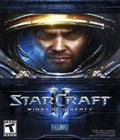Designed to be the ultimate competitive real-time strategy game, StarCraft II will feature the return of the Protoss, Terran, and Zerg races, overhauled and re-imagined with Blizzard's signature approach to game balance. Each race will be further distinguished from the others, with several new units and new gameplay mechanics, as well as new abilities for some of the classic StarCraft units that will be making a reappearance in the game. StarCraft II will also feature a custom 3D-graphics engine with realistic physics and the ability to render several large, highly detailed units and massive armies on-screen simultaneously.
Many experiments with dedicated air-to-ground attack have been undertaken by the terrans. Various dead-end approaches were tried and then discarded: ordnance packages for dropships, remote semi-autonomous drones, and airborne artillery platforms, to name but a few. Such continual compromises eventually led to retrofitting variants of the Wraith space superiority fighter with a belly-mounted burst laser to fulfill the role in the short term. Even so, the abiding problem of finding truly effective air-to-ground support below battlecruiser weight remained.
Procyon Industries has been the latest to tackle the problem by approaching it from a different direction. Instead of attempting to adapt existing aircraft designs for a role they were never intended to fulfill, the technicians at Procyon designed the banshee from scratch. As a planetary craft, the banshee wouldn't need high-powered engines to achieve escape velocity and fight in orbit, so instead technicians fitted it with economical twin turbofans. Any air-to-air weaponry was deemed unnecessary: the banshee would only hunt ground targets. Thus, it was equipped with powerful air-to-ground cluster rockets.
The resulting aircraft was cheap, relatively robust, and well suited to its intended role of making tactical strikes on the battlefield. The banshee was adopted by the Dominion as a light infantry support craft that could be quickly transported to any world. Despite the banshee's many fine traits, Dominion commanders initially derided its apparent inflexibility and relegated banshees to a minor support role in backwater militias.
However, with the benefits of being lighter and much more mobile than a siege tank, the banshee soon gained itself a fearsome reputation in spite of its detractors. It particularly shone as a jungle and desert fighter that could hunt across vast areas of inhospitable terrain and suddenly strike at unsuspecting enemy forces. The surprise attack value of the banshees has been further enhanced by modifications that allow them to mount salvaged Wraith cloaking fields, enabling banshees to hit and run even where the enemy dominates the skies.
As the Dominion conquered additional terran worlds, the banshee was cast into a new role. Guerilla freedom fighters making hit-and-run raids against Dominion forces found themselves hunted by banshees that could respond quickly enough to catch them as they were fleeing to their hidden bases. In recent years the banshee has gained a nasty reputation as a Dominion terror weapon because it has been used more and more often in urban conflicts, where its indiscriminate attacks have killed countless non-combatants.
StarCraft II will include a unique single-player campaign, as well as fast-paced online play through an upgraded version of Blizzard's renowned online gaming service, Battle.net®. In addition, the game will come with a powerful, full-featured map editor that will put the same tools used by Blizzard's designers into the hands of players.
Blizzard is developing StarCraft II for simultaneous release on the Windows and Macintosh PC platforms. Further information about the game, including details on the single-player, multiplayer, and map-editor features, as well as system requirements, pricing, and availability, will be announced in the months ahead.
More articles about StarCraft II











 Designed to be the ultimate competitive real-time strategy game, StarCraft II will feature the return of the Protoss, Terran, and Zerg races, overhauled and re-imagined with Blizzard's signature approach to game balance. Each race will be further distinguished from the others, with several new units and new gameplay mechanics, as well as new abilities for some of the classic StarCraft units that will be making a reappearance in the game.
Designed to be the ultimate competitive real-time strategy game, StarCraft II will feature the return of the Protoss, Terran, and Zerg races, overhauled and re-imagined with Blizzard's signature approach to game balance. Each race will be further distinguished from the others, with several new units and new gameplay mechanics, as well as new abilities for some of the classic StarCraft units that will be making a reappearance in the game.